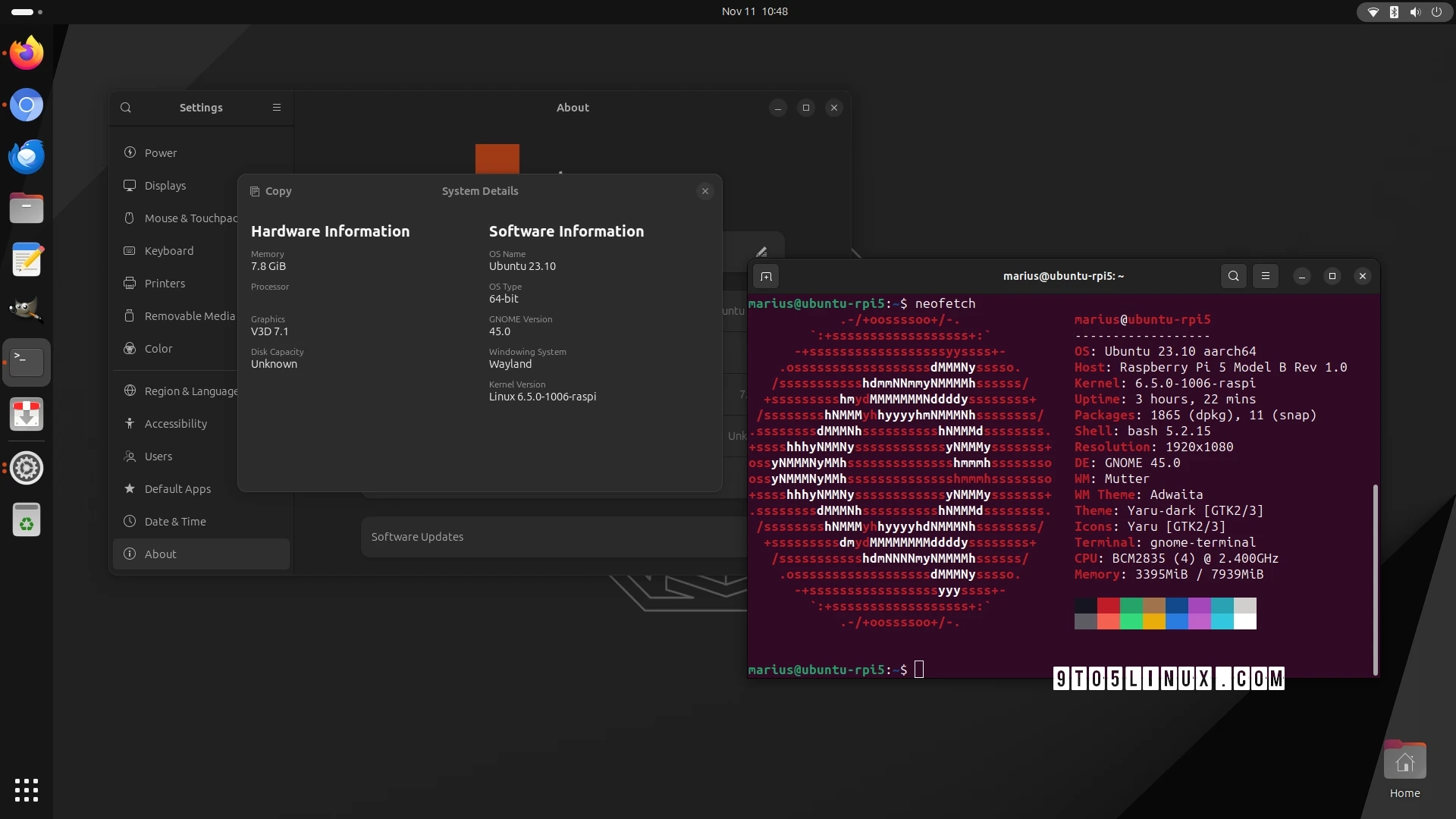My Raspberry Pi 5 finally arrived yesterday so the first thing I did after I’ve set it up was to try various GNU/Linux distributions, ending up with Canonical’s latest Ubuntu 23.10 (Mantic Minotaur) release. Expect this to be a review of both software and hardware.
Why Ubuntu 23.10? Because it would be redundant to write about the Raspberry Pi Foundation’s own Raspberry Pi OS on the Raspberry Pi computer, and because, right now, Ubuntu 23.10 is the only GNU/Linux distribution that offers official support for the Raspberry Pi 5 model.
I initially wanted to make a versus article (e.g. Fedora Linux vs Ubuntu on Raspberry Pi 5), but Fedora Linux 39 doesn’t appear to work on Raspberry Pi 5 as it’s not officially supported, and that’s a shame. Hopefully, next year’s Fedora Linux 40 will offer official support for Raspberry Pi 5 computers.
Until then, we have Ubuntu 23.10 to play with on the Raspberry Pi 5, and it is quite nice. I really like the fastness of Raspberry Pi 5 compared to Raspberry Pi 4, but don’t expect it to replace your laptop or desktop computer anytime soon.
Ubuntu 23.10 booting straight to the desktop in just 4-5 seconds is impressive. The GNOME 45 desktop environment is as expected, functioning magnificently, but falls short in recognizing the Raspberry Pi hardware. The System Details tab in the GNOME Control Center only displays the RAM and graphics.
While it provides most of the applications crucial for daily home office tasks, the persistent problem of accessing DRM-protected content remains unsolved, which is rather regrettable.
Ubuntu 23.10 includes Snap versions of both Mozilla Firefox and Chromium web browsers, however, they lack patches against Widevine, Google’s content security system. It’s impossible to activate DRM playback and it’s puzzling why this is still an issue in 2023, especially when Raspberry Pi OS supports DRM right out of the box.
Even if you install Firefox as a DEB package or get Chromium DEB builds with Widevine from the Raspberry Pi Foundation, you still wouldn’t be able to play DRM-protected content via Spotify, Netflix, Prime Video, etc. Consequently, YouTube might be your sole choice for video streaming and music playing.
Many of you may find the lack of DRM-locked content on Ubuntu for Raspberry Pi problematic, for which you’ll still require the Raspberry Pi OS. Furthermore, YouTube 4K content isn’t playable on the Raspberry Pi 5, though QHD (1440p) is viewable.
Nevertheless, watching QHD content in one web browser while using another browser, and also image editing on GIMP, can considerably slow down the Raspberry Pi 5 experience.
I admire the new active cooler of the Raspberry Pi 5 as it enhances the computing experience by generating less noise due to the amalgamation of an aluminium heatsink and a temperature-controlled blower fan. Overall, Canonical appears to have done quite well in optimizing their Debian-based operating system for the new Raspberry Pi.
For those that aren’t aware yet, Raspberry Pi 5 doesn’t come with a 3.5mm audio jack, which was present on all previous Raspberry Pi models. That’s an annoyance for me because I can no longer connect my stereo speakers and I have to rely only on a Bluetooth speaker from now on.
I should mention the fact that I am running Ubuntu 23.10 on the Raspberry Pi 5 computer from an SSD drive in a USB-C enclosure connected to one of the USB 3.0 ports. There’s currently an issue if you change the boot order to USB boot first as Wi-Fi will no longer be available on the Raspberry Pi 5.
Until a firmware update solves this nasty issue, the only solution is to leave the boot order as it is from the factory or switch back to SD card boot first if you already changed it to USB boot first.
All in all, I am impressed with the Raspberry Pi 5, and with Ubuntu 23.10 on the Raspberry Pi 5, which delivers a nice computing experience for a small home office without any big expectations, but then again Raspberry Pi 4 was already capable of doing that. Luckily, the Raspberry Pi 5 is not that expensive.
Personally, I’m waiting for the official M.2 HAT for Raspberry Pi 5 to attach an NVMe SSD for a tidier setup of my Raspberry Pi-powered office and, hopefully, for a more streamlined experience, because let’s be honest here for a moment, SD cards are a thing of the past and I don’t think Raspberry Pi Foundation expects us to run a full-fledged distro on the powerful Raspberry Pi 5 from a microSD card.
Last updated 7 hours ago
